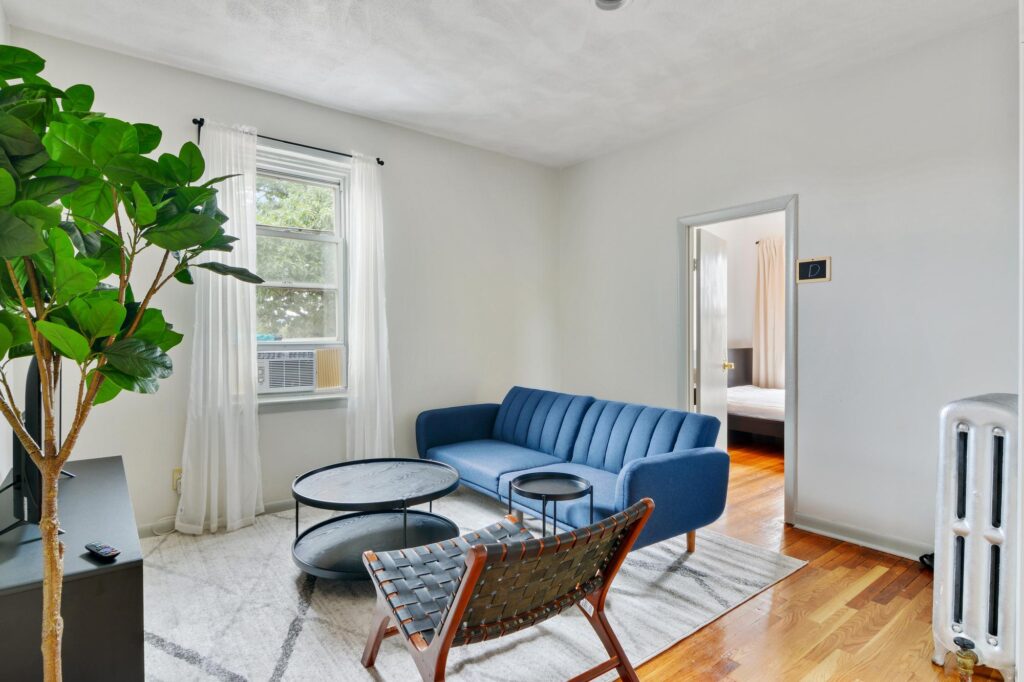
Estimated reading time: 10 minutes
How Much Rent Can You Afford?
How much rent you can afford depends on your monthly income, other expenses, and the type of apartment you want. A common rule of thumb is the 3x rent rule: your gross monthly income should be at least three times the rent.
Example: If you earn $4,500 per month before taxes, you can comfortably afford around $1,500 in rent.
Consider your city: In high-cost areas like NYC, Boston, DC, or Chicago, average rents may require adjusting this guideline or finding roommates.
Other factors: Utilities, debt, and savings goals should be included in your budget to avoid financial strain.
💡 Use our rent calculator to see exactly how much rent fits your budget in your city and household situation.
Calculate Rent Based on Annual Salary
Calculate Rent Based on Monthly Salary
Related Tools to Help You Calculate Rent
- Hourly Pay to Rent Calculator
- Monthly Room Rent Calculator
- NYC Rent Calculator
- How Much Do You Need to Make to Afford Rent?
- 3x Rent Calculator
- Prorated Rent Calculator
- Renting an Apartment With No Income but Savings Calculator
- How to Split Rent Fairly — Rent Split Calculators
When it comes to finding a new place to live, one of the most important factors to consider is how much rent you can afford. While you may have your heart set on a spacious apartment with all the amenities, it's essential to ensure that you can comfortably pay for it without sacrificing other essential expenses.
How Much Rent Can I Afford - Chart
| Your Annual Salary ($) | Monthly Rent ($) |
| 40,000 | 1,000.00 |
| 50,000 | 1,250.00 |
| 65,000 | 1,625.00 |
| 70,000 | 1,750.00 |
| 70,000 | 1,750.00 |
| 72,000 | 1,800.00 |
| 75,000 | 1,875.00 |
| 80,000 | 2,000.00 |
| 100,000 | 2,500.00 |
| 110,000 | 2,750.00 |
| 130,000 | 3,250.00 |
Enjoy a hassle-free, high-end rental experience for stays of one month or longer in major US cities.

Fully-furnished rooms and apartments with flexible lease. Apply today and move in tomorrow.
Probably, You're Curious
You might be wondering how much rent you can afford to live comfortably while keeping your finances in check. There is no one-size-fits-all answer, as the amount you can afford will depend on your income and expenses.
When considering moving to a new place, your finances are a priority. Renting is a significant financial responsibility affecting other aspects of your life. Also, understand that it goes beyond your monthly rental payments as there are other expenses to think about.
As such, it’s important to determine how much of your salary should go to rent. There are widely accepted rules, such as the 50/30/20 rule, you can use to determine your ideal rent-to-income ratio and how much you should spend on rent.
We’ve prepared answers to commonly asked questions on rent calculations.
What is 3 times the rent rule?
The "3 times the rent" rule is a guideline that is often used to determine how much a person or household can afford to pay in rent. According to this rule, a person or household should not spend more than 3 times their gross monthly income on rent.
For example, if a person earns $3,000 per month before taxes, they should not pay more than $900 in rent. This rule is based on the idea that housing expenses, including rent and utilities, should not take up more than a third of a person's income.
While this rule can be a useful guide, it is important to keep in mind that actual rent prices can vary significantly based on a variety of factors, including location, local cost of living, and the availability of affordable housing units. It is always a good idea to carefully consider your budget and financial situation when looking for a place to rent.
What is the 50/30/20 rule?
The 50/30/20 is a guideline for allocating your budget into three categories—needs/necessities, wants, and savings.
According to the rule, necessities like rent, groceries, health, insurance, minimum debt repayments, and utilities should take up 50% of your after-tax salary. This does not include extras like dining out and Starbucks, even if you might see them as food expenses.
Any wants should take up 30%. These are things you desire but are not absolutely essential for you to survive. They include dining out, vacations, hobbies, entertainment services like Netflix and sports tickets, and upgrade decisions like choosing between using an Uber or public transport.
Finally, allocate 20% towards savings and investments, such as making IRA contributions, funding an emergency account, and investing in money markets. It also includes debt repayment. While minimum debt repayments are allocated for in the needs category, making extra debt repayments will reduce the amount you owe and the interest. It’s therefore considered as savings.
What percent of income should go to rent?

20%
Spending 20% of your income on rent allows you to save more and repay large debts. But if you’re not careful, you could spend more on non-essentials. Spending 20% also means you’ll have to avoid costlier neighborhoods and metros. But if you prefer to forego extra comfort to save more, spending 20% can help you reach your goals.
30%
Spending 30% of your income on rent is a rule of thumb. It allows you to afford comfortable housing, still have enough money left for other living expenses, and contribute toward your savings goals. 30% will get you a comfortable, decent apartment on a regular, medium income.
40%
If you think you’ve found the perfect house or want to live in a metro area close to amenities and leisure facilities, you might be tempted to spend more on rent. However, spending an extra 10% every month can make a significant difference over time and has risks. If your income is above average, spending 40% on rent should afford you a larger space in a good area.
Is it OK to spend half salary on rent?
Well, it really depends on your personal financial situation. If you're making a pretty penny and have minimal other expenses, maybe you can swing it. But for most of us, spending half of our income on rent doesn't leave a lot of wiggle room for other expenses like food, transportation, savings, and don't forget, a little fun now and then!
Most financial experts suggest aiming for about 30% of your income to go toward rent. This leaves you with a more balanced budget, and let's be honest, a little more peace of mind. But remember, there's no one-size-fits-all answer, so make the choice that works best for you.
How much rent can I afford?
To know how much rent you can afford, you need to calculate your monthly budget first. A budget helps you know where your money is going; then, make a plan of where you want it to go.
Make a list of everything you spend on monthly and the amounts. Categorize them into needs, wants and savings. Based on your after-tax income, use a rent budget calculator to determine if your present savings are in line with your financial goals.
The general rule is to spend 30% of your income on rent. However, although it works for many renters, it is not the ideal percentage for everyone. For instance, it doesn’t account for people with large outstanding or high-interest debt. Also, understand that besides your monthly rent payments, you’ll need to spend on other costs like utilities, transport, and health.
How much rent can I afford on $60k?
If you make $60,000 per year — using the 30% standard — you can afford to spend $18,000 per year on rent or $1,500 per month before taxes. Using the 50/30/20 percent rule, you’ll have $30,000 annually or $2,500 a month to cover your essentials, which includes rent.
The best way to figure out how much rent you can afford on $60K is to list all your essential expenses and use a rent calculator based on salary. Input your net income, expenses, and the percentage you’re willing to spend on rent in this rent calculator. It’ll show you how much rent you can afford and potential amounts in annual savings.
If you make $53,000, we suggest spending no more than $1,325 on rent accordingly.
Don't forget about additional costs
When moving into a new house, bear in mind that besides your monthly rent payment, you will also have other upfront costs you’ll need to pay. If you use an agent, you might pay an agent’s fee equivalent to one month’s rent or 10-15% of your annual lease amount. Other costs include security deposit, parking fees, application fee, pet deposit, furniture, and moving expenses.
In addition, you’ll have utilities and recurring monthly expenses to pay along with your rent. Expenses, such as renter’s insurance, amenities like a pool, gas, electric, and water bills, monthly pet fee, internet/cable fees, and extra storage space, will add up to higher rental costs.
Consider all your additional costs when deciding how much to spend on rent. Contact utility providers to get the average utility costs at your new address if possible.
How Do I Qualify as a June Homes Resident?
Here’s what you’ll need in order to qualify as a resident, based on the city you want to live in.
New York City, Boston, Washington DC, San Francisco, and Chicago:
- Proof that your monthly income is 3x the monthly rent or proof that you have 60x the monthly fee in cash assets. You can prove cash assets by providing banking statements.
- An above 650 credit score.
- Proof that your monthly income is 3x the monthly rent or proof that you have 60x the monthly fee in cash assets. You can prove cash assets by providing banking statements.
- An above 630 credit score.
- Proof that your monthly income is 3x the monthly rent or proof that you have 60x the monthly fee in cash assets.
- An above 550 credit score.



